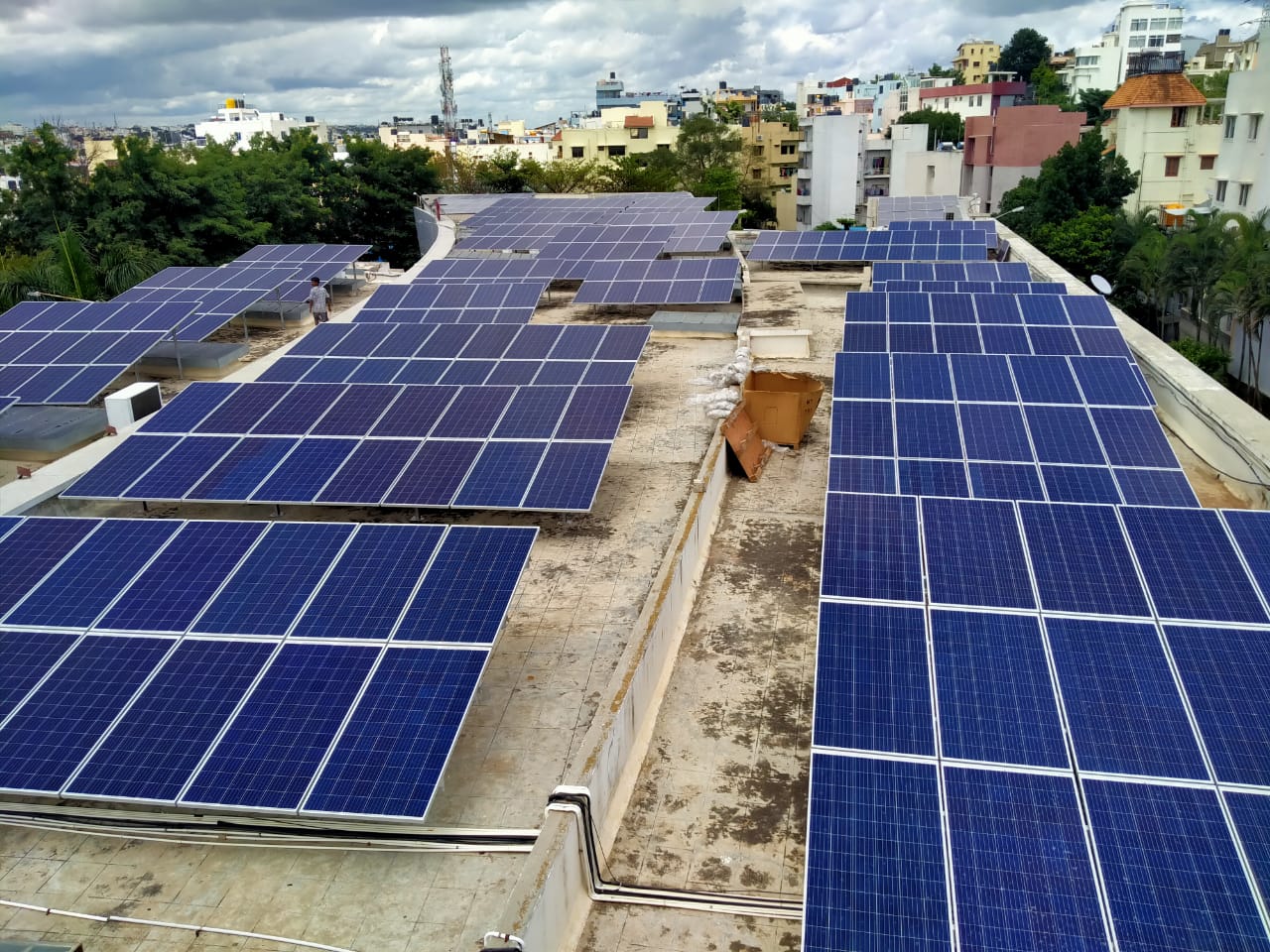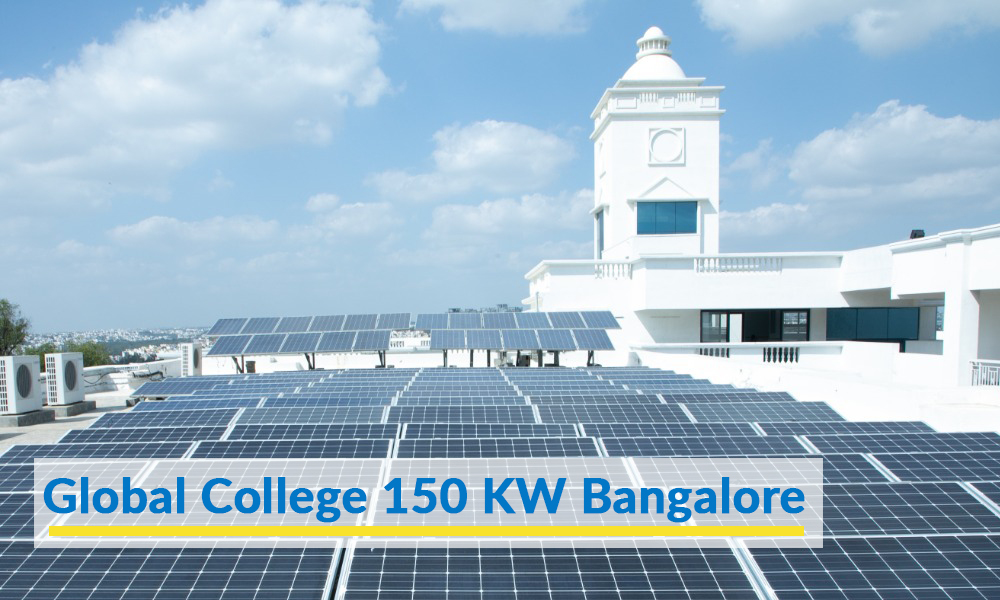Overview
With an On-grid solar system, you can export excess power generated at your home, to the grid on a sunny day and import power for your home’s needs from the grid on a cloudy day when you have a short supply of power. In this battery-less system, the solar generation is first used to meet the demand of the existing loads, and any excess generation is exported to the grid. If there is a short-supply or no solar generation, then the required energy is imported from the grid. These systems do not require batteries and are powered by the electrical grid.
A net-meter is a device that keeps track of how much energy is delivered to the grid and how much energy is taken away from it. A bi-directional net metre records the exported and imported electricity, and the consumer is charged only for the net electricity consumed from the grid at the end of the billing cycle. An on-grid solar system is also known as a grid-tied or grid-interactive solar system and is the most widely used type of photovoltaic (PV) power.
On-grid solar systems work extremely well for consumers who have reliable grid electricity and few power outages. Apart from residences, these systems are used as the principal source of power in educational institutions, industrial units, and commercial businesses.
How does an On grid PV system work?
The sun shines on the solar panels, which generate electricity. The inverter converts the DC from the sun into AC, which is then used by consumers in their homes or in commercial establishments. Any solar system’s functions are the same until this point. Beyond this point, the main distinction exists. Following our consumption of power, the surplus energy generated can take one of two paths:
- It can be stored in batteries and used later in the day (off-grid solar system) or it can be used immediately.
- Or it can be fed to the grid (on-grid solar system). Based on the feed-in-tariff rates (tariff fixed by the government for the purchase of solar power generated by solar plants) in your area, your electricity bill is reduced for the amount of power that you have sold to the power grid.

Components
Solar Module
The basic components of an on-grid solar system are solar panels. They are the components that capture solar energy and convert solar energy into electrical energy, and they account for more than half of the overall cost of a solar system.
Earthing Kit
An earthing kit protects the on-grid solar system from thunder.
Module Mounting Structure
Panel stands are also an important part of the solar system overall. Some people pay little attention to this aspect and try to save money by employing a low-quality stand. However, it is worth noting that this stand will support the solar panels, and if it is not solid enough, your solar panels may fall, resulting in a significant loss. Aluminum or galvanised iron are commonly used for these stands. To track the sun, solar panel platforms can be fixed or flexible.
Net metering and solar metering
Net metering is a specialised metering and billing agreement between utilities and their customers that allows modest, renewable energy-generating units to be connected to the power grid. It is a crucial part of an on-grid solar system since it keeps track of the readings so you can get credit on your electricity bills in the future. Solar energy, unlike other sources of renewable energy, is produced in large quantities in both the residential and commercial sectors, making net metering extremely significant.
DCDB/ACDB
A DC Distribution Board (DCDB) connects the solar panel’s output to the inverter’s input, whereas an AC Distribution Board (ACDB) distributes electrical power from a solar inverter to an AC load system via an energy metre.
Protection Devices
Protection devices are used to protect the solar system from harm, such as lightning and other defective situations. Surge arrestors, circuit breakers, and grounding methods are examples of these.
Solar Wire and Accessories
In a full circuit, a direct current (DC) electric circuit consists of a source of DC electricity—such as a battery—and a conducting wire running from one of the source terminals through a set of electric devices and back to the other terminal. It is used to set up on-grid and off-grid solar systems, as well as street lights, residential lighting systems, and other DC-based systems.
The Lightning Arrestor: It is used to safeguard the solar system against lightning while it is connected to the grid.
Solar Inverter: The solar panel produces DC output, which is converted to AC supply by the inverter
Installation Accessories: Wires, cables, mounting structures, junction boxes, and other installation accessories are included in this category.

FAQs
The amount of energy you use from your grid supply each month is the determining factor to consider when choosing a solar system capacity. Please keep in mind that the goal of installing an on-grid solar system is to lower your electricity costs.
The cost of an on-grid solar system varies depending on the brands utilised, the quality of the items used, and the system replacement guarantee.
The benefit of an on-grid solar system is that if you are not using electricity at home, the power generated by the solar system can be put back into the grid. The state government would compensate you financially for supplying power to Gird.
Installing on-grid solar systems and taking advantage of net metering policies can help people save money on their electricity bills. However, before the installation, a buyer may have a number of questions about the concept, subsidies, suppliers, installation method, and current net metering rules, among other things. Nuetech Solar has the right people, products, and services to answer all your queries, and we will do it for you happily.
Gross metering: A consumer is compensated at a fixed feed-in-tariff for the total number of units of solar energy generated and exported to the grid (as measured by a unidirectional ‘gross metre’) and must pay the electricity distribution company at retail supply tariff for the electricity consumed from the grid under gross metering. Feed-in tariffs and retail supply tariffs are usually not the same.
Net metering: Net metering is a system in which power exports are offset by imports, decreasing the electricity bill by deducting electricity generated from total electricity consumed over a set period of time. On a monthly, half-yearly, or annual basis, the adjustment can be made. A bidirectional ‘net metre’ typically accounts for both power import and export. If the exported electricity is greater than the imported electricity, the surplus electricity supplied into the grid may or may not be paid (depending on the state’s net metering rules).
Benefits :
- Increased earning potential: With a net metre installed in your home, you can trace the number of units you send to the power grid and claim a credit on your home electricity bill. This is a profitable choice for consumers who see it as an additional source of income.
- More savings: The primary goal of an on-grid solar system is to lower your electricity expenses. You can tailor your consumption to match peak demand hours and avoid paying peak demand charges. These are the higher rates that the utility assesses for accessing the grid during peak demand periods. In addition, net metering allows you to save money on your electricity costs while also allowing you to earn more.
- Profitable investment: An on-grid solar system is a profitable investment. It has a payback period of five years and will deliver free electricity for the next two decades. By investing in solar, you may turn your own land into a revenue-generating avenue in as little as 3–4 years.
- Efficient working: the on-grid system is efficient since it is in tune with the grid. There are no restrictions with a grid-tied solar system; you can use it to power any home appliance. It also runs entirely on solar power, which is generated by solar panels.
- Easy on the pocket: Because an on-grid solar system does not require batteries, it is less expensive to install than an off-grid system. When compared to other solar systems, it is less expensive.
- Low maintenance
